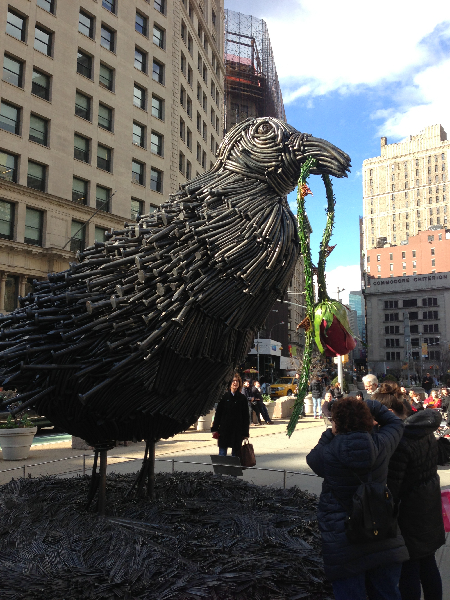As always, I’m thinking about women artists. I had another article published in Art Times Journal, this time on Lilly Martin Spencer, a remarkable woman and artist. Check it out here.
And I’m writing for Site Projects about public art works in New Haven for a new digital catalog. Here’s my essay on Nancy Holt’s work.
Nancy Holt, 1938-2014
End of the Line/West Rock, 1985
Environmental Sculpture, stone, masonry, steel, 11’ x 28’ x 18’
Location: Southern Connecticut State University, Farnam Avenue, near Brownell Hall, New Haven, CT.
 Carefully placed granite boulders snake along as if guiding the viewer to a ritual site. They point to the curving line that now swoops up, rocks piled high. The stones are fitted together, like a Connecticut stone wall, to form a monument—Nancy Holt’s End of the Line/West Rock. The environmental sculpture’s gentle stone curve cups the viewer, drawing attention to the central rings of steel. The manmade and natural meet.
Carefully placed granite boulders snake along as if guiding the viewer to a ritual site. They point to the curving line that now swoops up, rocks piled high. The stones are fitted together, like a Connecticut stone wall, to form a monument—Nancy Holt’s End of the Line/West Rock. The environmental sculpture’s gentle stone curve cups the viewer, drawing attention to the central rings of steel. The manmade and natural meet.
Stepping into the designated steel circle, the viewer peers through this concentric-ringed viewfinder for a perfectly framed picture of the West Rock outcropping. The view includes the manmade, too, a University building. Holt has again blended nature and the constructed, a frequent juxtaposition in her work.
Holt was part of the Land Art movement, beginning in the late 1960s, which coincided with environmental awareness activism and the dialogue about what materials and scale constitute fine art. This work demonstrates how the geological formation is transformed into art when the viewer is guided to see it as such, by looking at it in a frame. The gallery is now the land, the picture is the focal point determined by the artist. Holt has altered the place and shaped viewer perception.
The work is site specific. Holt has engineered the sculpture to take advantage of the available natural and constructed features of the site. The parking lot and buildings were already present. Holt sited her sculpture on a hilltop with a clear view of the New Haven landmark. The 51 boulders march ever closer together along the 355-foot approach. The circular marker has been measured for the best vantage point through the viewfinder, with its 8’ outer ring and 6’ inner ring.
The sculpture makes the viewer aware of the often-overlooked, preserving and celebrating it. Holt’s love of photography is evident in the picture-framing device she uses. With End of the Line/West Rock, Holt asks viewers to be mindful of their impact on nature and to take responsibility for it. She said, “I am giving back to people through art what they already have in them.”
Commissioned: The State of Connecticut’s Percent-for-Art Public Art Program
What I don’t write is that Nancy would be turning over in her newly dug grave, she passed in February, to see the site as it is now. Weeds are growing over the site marker. Discarded water bottles, Coke cups, broken pens, human detritus are tossed all over. Sigh.






 A curator from MoMA was in town to discuss a Claes Oldenburg sculpture on the
A curator from MoMA was in town to discuss a Claes Oldenburg sculpture on the 
 We watched a film of the fabrication, done by Lippincott in North Haven nearby. That foundry also fabricated Barnett Newman’s works of broken obelisks. They apparently knew what they were doing.
We watched a film of the fabrication, done by Lippincott in North Haven nearby. That foundry also fabricated Barnett Newman’s works of broken obelisks. They apparently knew what they were doing.




